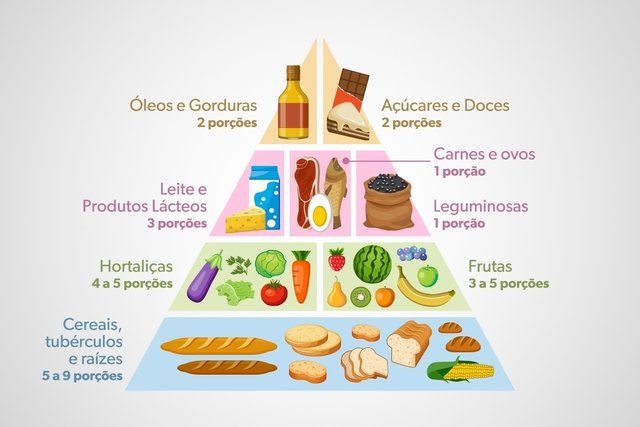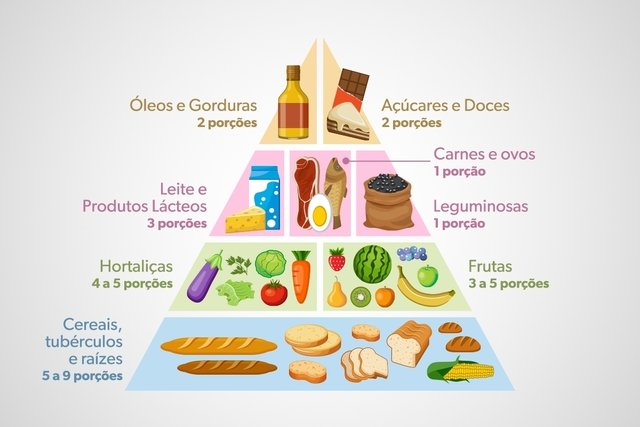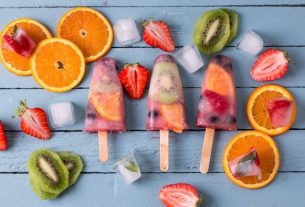The food pyramid is a graphic representation of the food groups that should be part of your daily diet. Using the food pyramid, it is possible to visualize the types and quantities of food that should be consumed per day, and is especially used by nutritionists. One of the objectives of the food pyramid is to promote adequate body weight and increase the consumption of foods such as fruits, vegetables and legumes.
The distribution of food groups in the pyramid is done from bottom to top. The foods that should be consumed in greater quantities are at the base and those that should be consumed in smaller quantities are at the top of the pyramid.
However, the food pyramid was adapted to the Brazilian public and, over the years, it has been replaced by other tools in some countries, as in the case of My Plate, which replaced the food pyramid in the United States, El Plato Del Bien Comer in Mexico, and the food wheel in Portugal.

What is it for
The food pyramid is one of the tools used by nutritionists and serves to promote adequate eating habits and prevent the emergence of diseases such as obesity, diabetes and high blood pressure. Find out the 9 benefits of healthy eating and how to do it.
This pyramid makes it easier to visualize the different groups, helping to choose the healthiest foods, encouraging a varied diet, increasing the consumption of fruits, vegetables and legumes and reducing the intake of foods rich in fat, sugar and salt.
Brazilian food pyramid
The Brazilian food pyramid used the old North American pyramid as a base, and was adapted to Brazilian habits, foods and culture. This adjustment to the Brazilian reality was important, as foods such as beans, which are widely consumed in Brazil, needed to be kept in a separate group, for example.
In addition to recommendations on types of food, the Brazilian pyramid also suggests practicing physical activity for at least 30 minutes a day, 7 times a week and eating 6 meals a day, with breakfast, morning snack, lunch, afternoon snack, dinner and supper.
With the new adaptations, the division of the Brazilian food pyramid was divided into 4 levels and 8 food groups in total. Unlike the division of the North American pyramid, which had 4 levels and only 6 food groups.
Main groups of the food pyramid
The structure of the Brazilian food pyramid is divided into 4 levels that include 8 food groups:
- First level: contains the group of cereals, tubers and roots;
- Second level: contains the vegetable group and the fruit group;
- Third level: contains the group of milk and dairy products, the group of meat and eggs and the group of legumes;
- Fourth level: contains the group of oils and fats and the group of sugars and sweets.
The food pyramid is subdivided into 8 groups and each group encompasses different types of foods:
Group 1: cereals, tubers and roots
The foods that are part of this group are at the base of the pyramid and include bread, flour, pasta, rice, and tubers, such as cassava, potatoes and sweet potatoes. The consumption of whole grains, such as brown rice and whole grain bread, should be prioritized, as these foods contain more fiber than refined foods. See more healthy whole grain options.
Recommended quantity: suggested intake is 5 to 9 servings daily.
Group 2: vegetables
Vegetables are part of the second level of the food pyramid, such as lettuce, tomatoes, pumpkin, zucchini and cabbage. Vegetables are rich in fiber, vitamins and minerals and should preferably be consumed fresh.
Recommended quantity: Consumption of these foods should be 4 to 5 servings per day.
Group 3: fruits
The foods that are part of this group are fruits such as banana, orange, papaya, mango and tangerine, which are naturally sources of vitamins, minerals and fiber and should be consumed, preferably raw, with the peel and avoiding cooking, making juices or candy.
Recommended quantity: the recommended intake for this group is 3 to 5 servings per day.
Group 4: milk and dairy products
This group is located at the third level of the pyramid and includes foods such as milk, cheese and yogurt, which are rich in protein and calcium. It is important to try to opt for versions with less fat, such as skimmed milk and white cheeses.
Recommended quantity: It is recommended to eat 3 portions of these foods per day.
Group 5: meat and eggs
This group is made up of proteins of animal origin, such as beef, pork, poultry, eggs, fish, offal and offal. Animal proteins are rich in iron and vitamin B12 and it is important to prioritize white meats such as fish and chicken, as they have less fat.
Recommended quantity: It is recommended to eat 1 to 2 portions of these foods per day.
Group 6: legumes
Legumes are widely consumed in Brazil and are sources of vegetable protein and fiber and the foods in this group are beans, peas, chickpeas, soybeans, broad beans and peanuts.
Recommended quantity: the suggested consumption of these foods is 1 portion per day.
Group 7: oils and fats
Despite being important for the body, oils and fats are very high in calories and should be consumed in moderation and, therefore, are at the bottom of the pyramid. Foods in this group are margarine or butter, olive oil and other vegetable oils.
Recommended quantity: suggested intake is 1 to 2 servings per day.
Group 8: sugars and sweets
Foods in this group, such as honey, ice cream, chocolate and refined sugar, should also be eaten in moderation, as they are very high in calories and contain few important vitamins and minerals for the body.
Recommended quantity: the recommended intake is a maximum of 2 servings per day.
How to eat healthy
To help you eat a healthy diet, the Ministry of Health created the Food Guide for the Brazilian Population. Among the recommendations, the manual explains that one should prioritize natural foods such as fruits, vegetables, whole grains and yogurts and moderate the intake of foods with a lot of fat, such as margarines and vegetable oils, and ultra-processed foods, such as stuffed biscuits, snacks package, soft drinks and instant noodles.

Sign up for our newsletter and stay up to date with exclusive news
that can transform your routine!
Warning: Undefined array key "title" in /home/storelat/public_html/wp-content/plugins/link-whisper-premium/templates/frontend/related-posts.php on line 12
Warning: Undefined array key "title_tag" in /home/storelat/public_html/wp-content/plugins/link-whisper-premium/templates/frontend/related-posts.php on line 13




